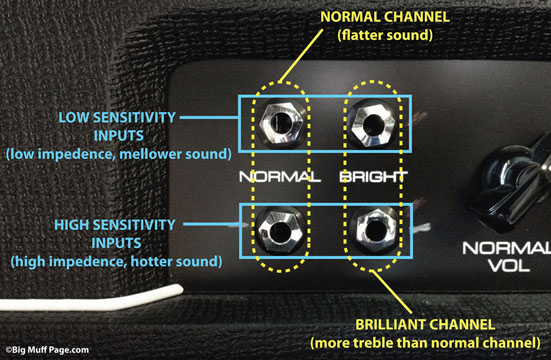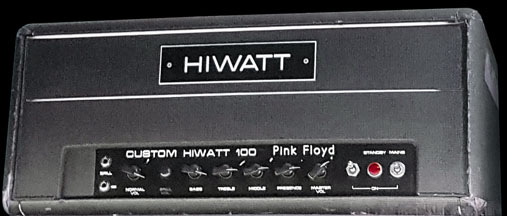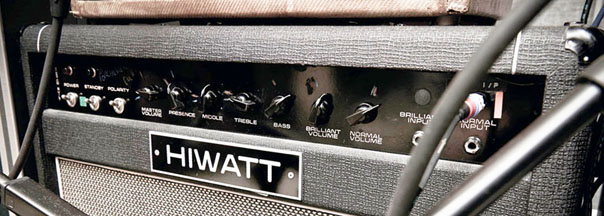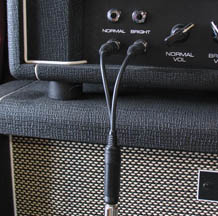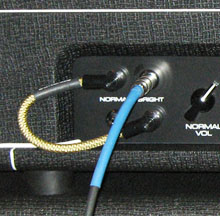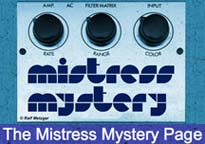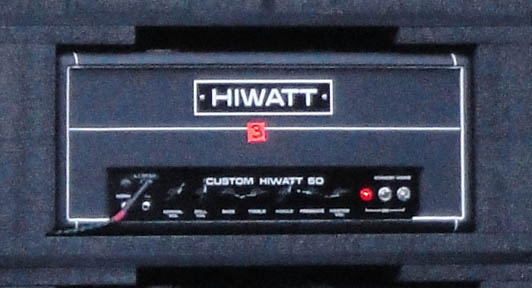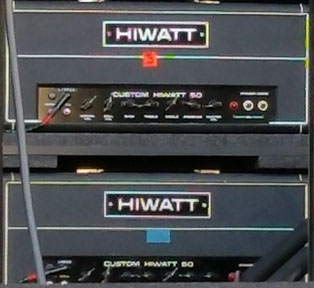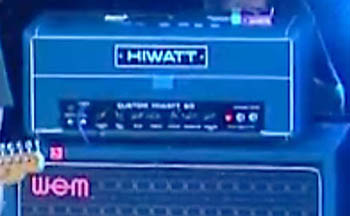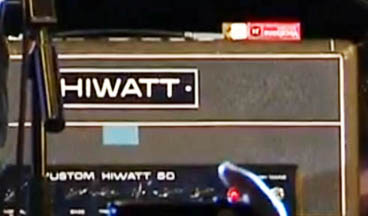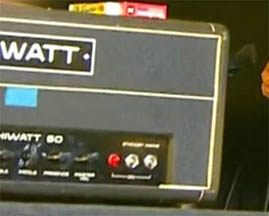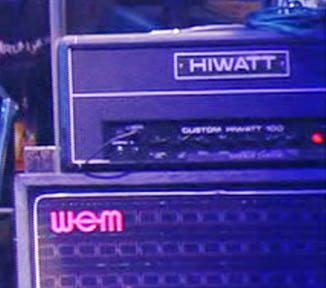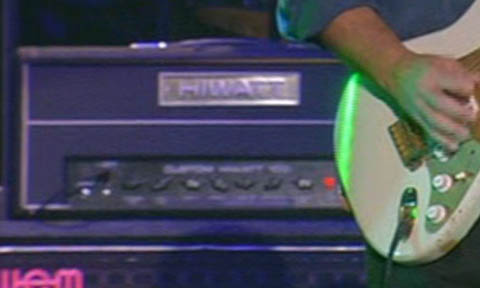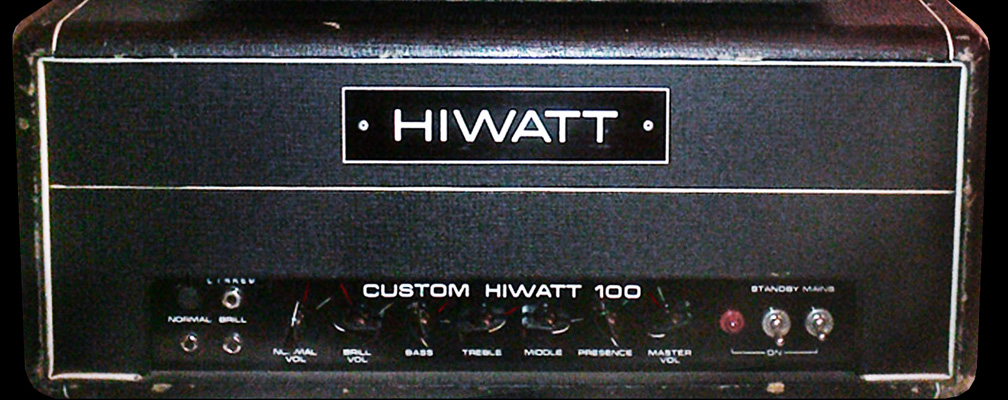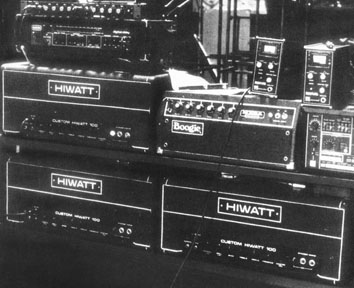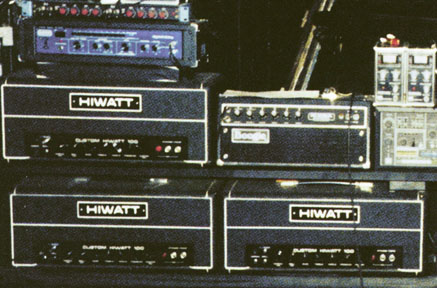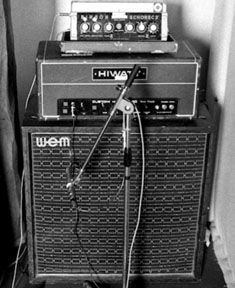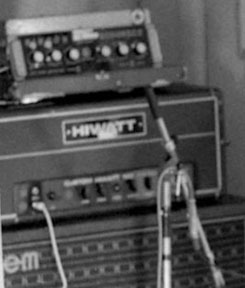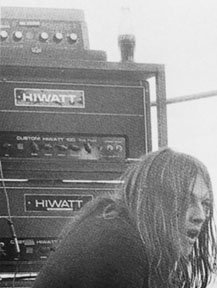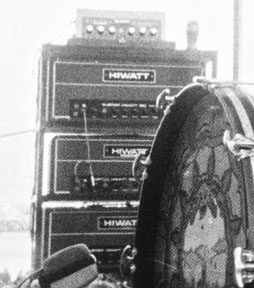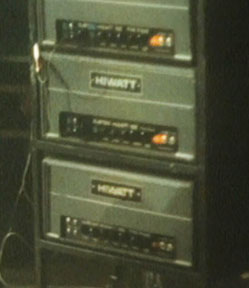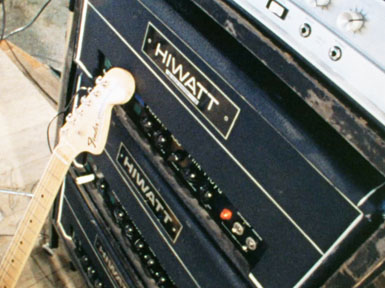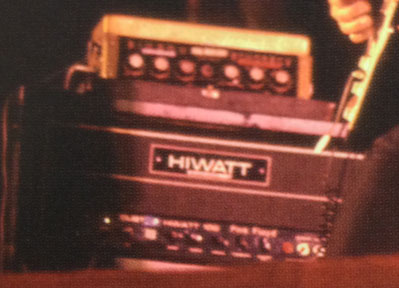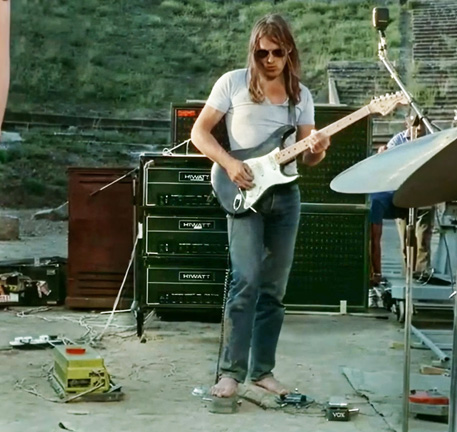NOTE: This website is frequently updated. Last update January 2023
LINKED INPUTS - Many high powered Marshall, Fender and Hiwatt amps have four inputs. Usually two inputs go to one channel and two to another. This was originally intended to allow more than one instrument to be plugged into the same amp. Each channel had a high sensitivty input and a low sensititvity input. The high sensitivity inputs are a bit hotter sounding and the low are a bit mellower sounding. If you have high output Strat pickup or Humbucker pickup, it may sound best and tamer through the low inputs. If you have a weak output pickup it may sound best through the high inputs. There is no right or wrong, it's just a matter of which input sounds best to you. Four-input Marshalls typically have the high sensitivity (high gain) inputs at the top and low sensitivity (low gain) inputs at the bottom. Most four-input Hiwatts have the reverse, low sensitivity inputs on top and high on the bottom.
The four inputs on a Hiwatt DR103 or Reeves Custom 50/Custom 100
Guitarists have been linking the input channels together on these four-input amps since the beginning, including Gilmour. Linking two channels allows a parallel (not stacked) blend of both channels simultaneously. This causes no harm at all to the amp and allows for more more tonal options when both channels are running at the same time. In the early days of Pink Floyd, from 1969 to Summer 1974, Gilmour used Hiwatt DR103 AP (all purpose) model 100w amps, made for him with "Pink Floyd" engraved on the faceplate (all had AP in the serial number). These were modified so both the Normal and Brilliant channels were linked internally to the normal volume pot. The Brilliant volume pot was removed and the Normal inputs were taped over. David plugged into the High sensitivity Brilliant input. The exact wiring for this mod is unknown. The Brilliant volume pot may have been replaced by a fixed value resistor, or completely bypassed.
David Gilmour's Custom "Pink Floyd" Hiwatt 100s used from 1969-1973, with Brillaint volume pot removed and Normal inputs taped over
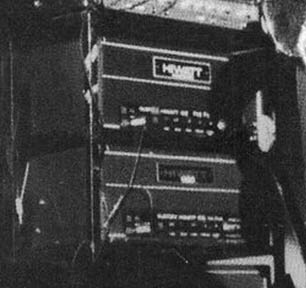
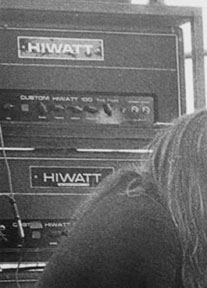
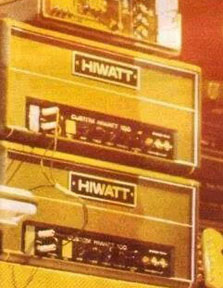
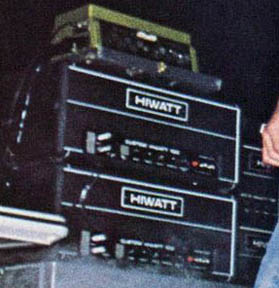
David Gilmour's Custom "Pink Floyd" Hiwatt 100s from 1971 (left), and Custom 100s from 1973 (right)
all with Normal inputs taped over and Brillaint volume pots removed
The Hiwatts David used from 1969-74 had a preamp tonestack that was similar to early Fender and Marshall tone stacks, different from the preamp tone stack that became the standard in later DR103s. During the band rehearsals in the Summer of 1974 Phil Taylor, David's new backline tech, bought several new Hiwatt DR103 models from current production. David used these for practically every Pink Floyd tour thereafter, and his solo tours up to 2016. David linked the High Sensitivity inputs of each channel on these Hiwatts, and later had them modified to have this linking done internally. Effects rig legend Pete Cornish made these mods, wiring the two high sensitivity inputs (each with a 1MOhm resistor) to one of the other inputs, which had the input resistor removed. The fourth input was disabled and filled with a dummy plug. These are high impedance inputs, so linking them does not put a load on the guitar signal and there is no measurable signal loss. David's SA212 Hiwatt Combo amp also had the inputs internally linked.
David Gilmour's Hiwatt SA212 combo with internally linked inputs. The chassis is mounted upside down compared
to a Hiwatt DR103 so the linked inputs appear reversed, but they are actually the same.
To link the inputs on my Reeves Custom 50 I plug a Y cable into the high sensititvity inputs (bottom left and right inputs) to link both channels, which is mechanically the same as linking them internally. You can also link a high sensitivty input of one channel with the low sense of the other channel, or use a jumper cable to patch any two of the four inputs together, and plug the guitar into one of the other inputs. Many combinations work, but using a Y cable (a simple mono to split mono) is the easiest way to link them, and linking the high sensitivity inputs sounds best to me. The high sensitivity inputs are the bottom two on a four-input Hiwatt like the DR103 or DR504 (same on the comparable Reeves and Hi-Tone amps), and the top two on an SA212 Hiwatt combo (because the SA212 chassis is mounted upside down compared to the DR103).
Two methods of linking the inputs: (left) a Y-splitter cable (right) a patch cable
I have experimented linking the inputs on my 59 Bassman but I prefer the sound of only the bright input 1. I do not link the inputs on my Twin Reverb, as the channels are out of phase and sound a bit odd together. There is a extra triode (a gain stage) in the reverb channel of the Twin, and every triode the signal passes through inverts it. Linking the inputs causes no harm at all to the amp, but since each input signal is inverted, some of the signal is cancelled out. Some people still do it and like the sound, but it does not work for Gilmour tones in my opinion.
GILMOUR'S HIWATT SETTINGS - Below are David Gilmour's Hiwatt settings from photos taken during various Pink Floyd and David Gilmour solo concerts. These settings should only be used as a starting point for your settings since the sound will vary depending on the type of speakers used and the size of your speaker cabinet. The same amp settings through a large 4x12 cab like David used will NOT result in the same sound through a smaller 2x12 or 1x 12 cab, even if you are using the exact same speakers. You may have to dial down the highs and mids to get a similar sound through smaller cabs. Smaller cabs also have a tighter and more focused sound than the larger cabs, especially with closed backs.
Here are a few things to keep in mind.
• The number of speakers affects the tone. Due to the mutual coupling of sound waves coming from each speaker cone, and reflecting through the back of each speaker cone, each additional speaker added to a cab cancels out some of the high frequencies and boosts the low mids and low frequencies.
• A large cab with a single speaker will have a fuller sound and more low end than a small cab with the exact same speaker, especially if it is a closed back cab. A large cab with a single speaker will sound more similar to a large cab with two or four speakers than a small cab with a single speaker.
• Closed-back cabinets sound more focused, have a fuller low end, and project the sound in one direction. Open back cabs spread the sound more in all directions and can sound looser, with less low end.
Most of the settings below are very similar, with the exception of the 1977 Animals tour. Note, the AP (all purpose) DR103's David bought in the early years (1969-70) do not have the same preamps as the later ones he purchased around 1974, so these settings may not result in the exact same sound from your Hiwatt even when using the same type of cab and speakers David was using. Those early preamps were more like Fender or early Marshall preamps. Some of those Early Hiwatts had linear pots and some logarithmic/audio pots, which completely changes the taper/pot positions for the same sound. Also, tonal differences from the tubes used and changes in cap values because of age and/or changes to the pot values as the resistive film has gotten worn away over the years can alter the sound.

Here are David Gilmour's actual studio Hiwatt DR-103 settings from the Dark Side of the Moon through The Wall era. The upper normal input and lower brilliant inputs were internally linked, which is why there is a dummy plug in the upper left input.

For David's 2004 Strat Pack performance the settings changed as shown above. One DR-103 head was switched between a WEM 4x12 speaker cabinet and a Marshall 4x12 cab.

For David's 2006 tour the settings changed as shown above, based on the tic marks shown in the photos taken by Pete Cornish when he worked on the amps prior to the tour. The upper normal input and lower brilliant inputs are internally linked. Photos of the amp settings from the tour vary only slightly form these settings. Note that one DR-103 head poweried a Marshall 4x12 speaker cabinet, and another a WEM 4x12 speaker cabinet. Settings were identical except the bass was set slightly higher for the WEM cabinet (gray line). Your Hiwatt settings will vary depending on the cabinet type, speaker type, and number of speakers used, so this should only be used as a starting point for your own settings.
2015/2016 Rattle That Lock tour
The NORMAL and BRILL high sensitivity inputs are internally linked
Normal. Volume: 2:00
Brillant Volume: 12:30
Bass: 3:30
Treble: 8:30
Middle: 1:00
Presence: 9:30
Master: 8:30
2015 KOKO gig with Boombox
The NORMAL and BRILL high sensitivity inputs are internally linked
Normal. Volume: 2:00
Brillant Volume: 11:00
Bass: 2:00
Treble: 9:00
Middle: 12:30
Presence: 8:00
Master: 8:00
2014 Hiwatt SA212 settings from Hove studio
This is the same amp chassis and the DR103 head, just mounted upside down in the combo, so the inputs are upside down, but David's 212 inputs appear to be linked as if they were right side up, the same as David's Hiwatt heads. They may have been internally linked the same as the heads, but re-wired so that the upper right input is the linked input, since David is familiar with using that one on his Hiwatt heads.
Normal. Volume: 2:00 tic mark 12:30-1:00)
Brillant Volume: 12:00 (tic mark 11:00)
Bass: 1:30 (tic mark 11:00)
Treble: 9:30
Middle: 12:00
Presence: 10:30
Master: 9:00 (tic mark 8:00)
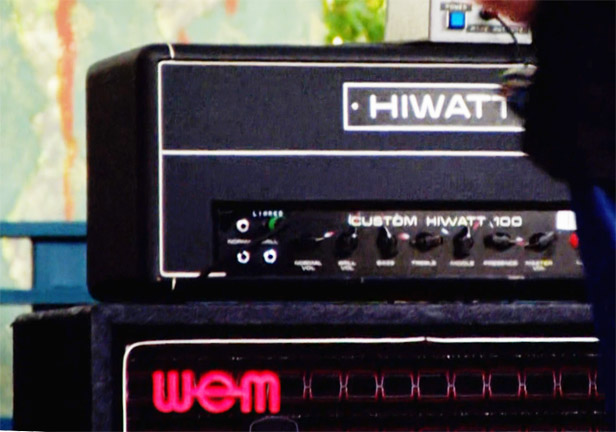
2006 Tonight Show performance
The NORMAL and BRILL high sensitivity inputs are internally linked
Normal Volume: 2:00
Brillant Volume: 1:00
Bass: 11:00
Treble: 9:00
Middle: 12:00
Presence: 3:00
Master: 9:00

2006 On an Island tour tic marks
The NORMAL and BRILL high sensitivity inputs are internally linked
Normal Volume: 2:00
Brillant. Volume: 1:00
Bass: 11:00
Treble: 10:00
Middle: 1:30
Presence: 3:00
Master: 9:00
2006 Pete Cornish pic - same tic marks on 3 Hiwatts (1994 tour Hiwatts)
The NORMAL and BRILL high sensitivity inputs are internally linked
Normal Volume: 2:00
Brillant. Volume: 12:00
Bass: 12:00
Treble: 9:30
Middle: 10:00
Presence: 10:30
Master: 9:30 -10:00
2004 Strat Pack concert
The NORMAL and BRILL high sensitivity inputs are internally linked
Normal Volume: 2:00
Brillant Volume: 1:30
Bass: 10:00
Treble: 10:30
Middle: 3:00
Presence: 1:30
Master: 9:00
2003 Interstellar Exhibition tic marks (1994 tour Hiwatts)
The NORMAL and BRILL high sensitivity inputs (bottom left and right inputs) are linked internally (each with a 1MOhm resistor) to the upper right input, marked LINKED. The upper left input is filled with a dummy plug.
Normal Volume: 2:00
Brillant: Volume: 1:30
Bass: 9:30
Treble: 10:00
Middle: 10:00
Presence: 1:30-2:00
Master: 8:30
1994 tour Hiwatts (from magazine photos)
Note - the pre amp was disconnected and tone section bypassed in this Hiwatt, which is why the Master Vol running the power amp was cranked so high and the pre and tone knobs dialed off. If you look close at the photo, you can see yellow tick marks showing David's knob positions from before the preamps were bypassed.
Normal Volume: 2:00
Brillant Volume: 1:00
Bass: 9:30
Treble: 10:30
Middle: 12:00
Presence: 3:00
Master: 1:30
1984 era Hiwatt Settings - DR103 kept in Brittania Row. Used by David from 1973-1984, based on the PJC service dates, which PJC confirmed. Auctioned in 2013.
The NORMAL and BRILL high sensitivity inputs (bottom left and right inputs) are linked internally (each with a 1MOhm resistor) to the upper right input, marked LINKED. The upper left input is filled with a dummy plug.
Red Grease Pencil Marks
Normal Volume: 12:30
Brillant Volume: 11:00
Bass: 1:00
Treble: 1:30
Middle: 3:00 (?)
Presence: 1:00 (?)
Master: 11:00
White Grease Pencil Marks
Normal Volume: 1:30
Brillant Volume: 1:30
Bass: 3:00
Treble: 1:30 (?)
Middle: 3:00
Presence: 1:00
Master: 11:30
1980 The Wall concerts - Pete Cornish photos
The NORMAL and BRILL high sensitivity inputs (bottom left and right inputs) are linked internally (each with a 1MOhm resistor) to the upper right input, marked LINKED. The upper left input is filled with a dummy plug.
Normal Volume: 2:00
Brillant Volume: 11:30
Bass: 1:00
Treble: 11:00
Middle: 11:30
Presence: 1:00
Master: 11:00
1977 Tour (pieced together from different, incomplete photos, and the Interstellar Exhibition photos)
Y cable plugged into upper and lower Brill inputs. Normal inputs taped over.
Normal Volume: 2:00
Brillant Volume: unknown
Bass: 1:30
Treble: 3.00
Middle: 3:00
Presence: 3:00
Master: 2:30 (one photo shows about 10:00-10:30)
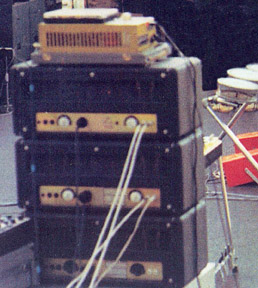
1974 Hiwatt tic marks
Normal. Volume: 2:00
Brillant Volume: 1:00
Bass: 1:00
Treble: 9:30
Middle: 10:00
Presence: 9:30
Master: 9:00
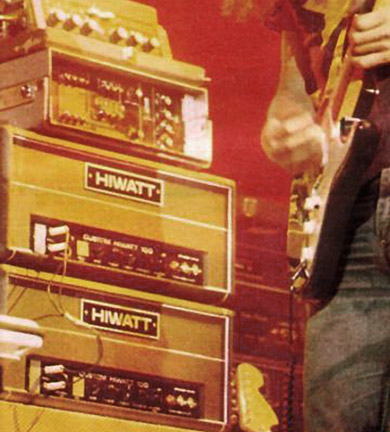
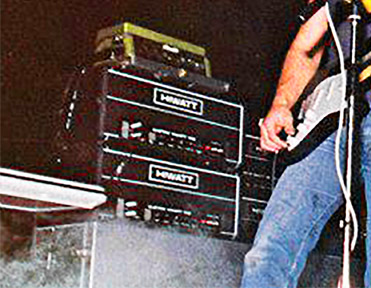
1973 tour photos from Earls Court (May 1973)
Y cable plugged into upper and lower Brill inputs. Normal inputs taped over.
Normal. Volume: 5:00 (maximum)
Brillant Volume: pot removed and taped over. If it was simply removed and bridged, same as setting pot at maximum.
Bass: 10:30
Treble: 3:15
Middle: 9:30
Presence: 3:30
Master: 5:00 (maximum)
1971 tour photos from Sydney Australia (August 1971)
Cable plugged into lower brilliant input. Upper and lower normal inputs are taped over.
Normal: 3:00
Brillant Volume: pot removed and taped over. If it was simply removed and bridged, same as setting pot at maximum.
Bass: 11:00
Treble: 3:30
Middle: 10:00
Presence: 3:30
Master: 5:00 (maximum)
1971 tour photos from Japan, August
Cable plugged into lower brilliant input. Upper and lower normal inputs are taped over.
Normal: 3:00
Brillant Volume: pot removed and taped over. If it was simply removed and bridged, same as setting pot at maximum.
Bass: 10:00
Treble: 3:30
Middle: 10:00
Presence: 4:30
Master: 5:00 (maximum)
1971 tour photos and films from Austria, August
Cable plugged into lower brilliant input. Upper and lower normal inputs are taped over.
Normal: 5:00 (maximum)
Brillant Volume: pot removed and taped over. If it was simply removed and bridged, same as setting pot at maximum.
Bass: 9:00
Treble: 4:30
Middle: 7:00
Presence: 3:00
Master: 5:00 (maximum)
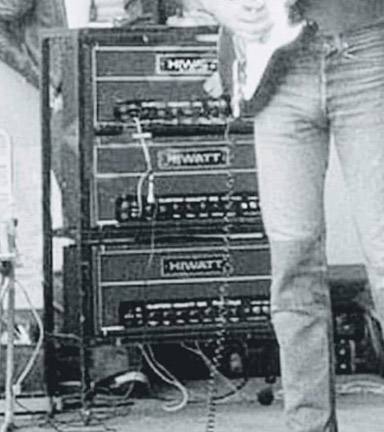
Kit’s Secret Guitar, Gear, and Music Page
Guitar stuff, gear stuff, soundclips, videos, Gilmour/Pink Floyd stuff, photos and other goodies.
Copyright Kit Rae.
VISIT MY SWORDS, KNIVES and FANTASY ART WEBSITE www.kitrae.net

